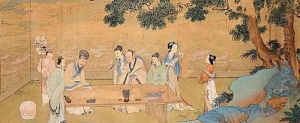Chou Ying Paintings
Chou Ying was a Chinese painter who lived during the Ming Dynasty, an era known for its cultural achievements and flourishing arts. Born in 1493, Chou Ying is sometimes also referred to as Zhou Jing or Zhou Jingxuan. His life spanned much of the 16th century, a period marked by political stability and economic prosperity in China, which allowed the arts to thrive.
Chou Ying was particularly well known for his meticulous brushwork and his contributions to figure painting, a genre that was highly esteemed during the Ming period. He was a native of Taicang, in the Jiangsu Province, and he belonged to a milieu of literati painters. These were scholar-artists who were educated in the classical Confucian texts and practiced painting not as a profession but as a means of personal cultivation and expression. They often used their art to reflect their intellectual pursuits and their understanding of nature and humanity.
Throughout his career, Chou Ying was associated with an elegant and refined style. His paintings often featured historical and legendary figures, rendered with a sense of grace and a focus on character portrayal. Chou Ying's ability to infuse his subjects with life while adhering to the traditional techniques and modes of Chinese painting made him a respected figure among his contemporaries and later generations.
Unfortunately, specific details regarding Chou Ying's life, including his education, patrons, and personal life, are scarce. However, his surviving works and their influence on later artists attest to his mastery and his role in the development of Ming Dynasty painting. Chou Ying's works were collected by connoisseurs and continue to be studied and admired for their beauty and historical significance. He passed away in 1560, leaving behind a legacy that would influence Chinese painting for years to come.
